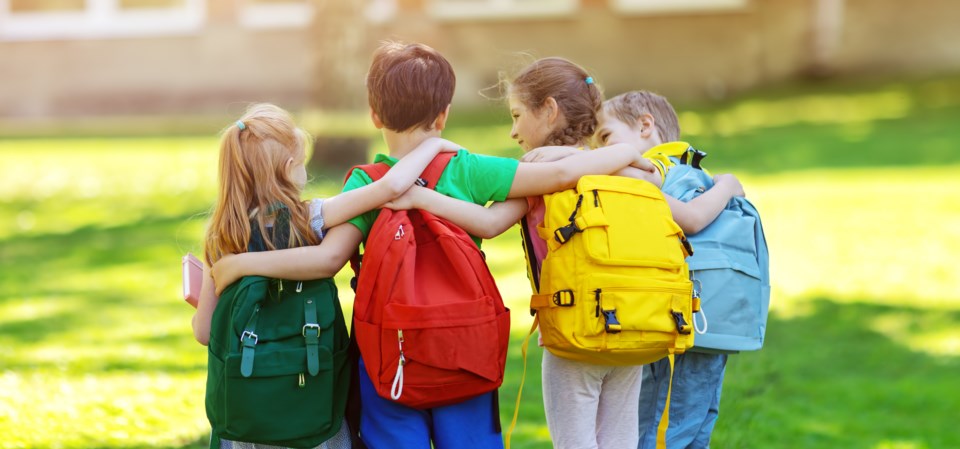It’s almost that time of year again! With the new school year right around the corner, back to school shopping is upon us. There’s a great deal of excitement that comes with the new school year. While shopping for new school supplies, clothes, shoes and bags is fun, we might not necessarily need all these things. With many schools in Greater Sudbury becoming EcoSchools, we have some great ways to help support their initiatives.
Below is a list of tips and tricks to save time and money while also helping the planet:
1. Assess what you already have
Once you get that back-to-school supply list, take inventory of what you already own. We all have a junk drawer, and this might be the perfect place to start your search. You can also review your collection of craft supplies for items you might need. Go through drawers, closets or storage containers for supplies such as pencils, markers, highlighters, binders, pencil cases, lunch boxes, gym shoes or school bags. Although these items might not be brand new, it’s as simple as giving a bag a quick clean or giving some coloured pencils a good sharpen! Reusing items that you already own is also a great way to reduce the clutter in your home.
2. Try thrift shops and school supply swaps
Try shopping at secondhand stores for clothing or school supplies - often, you can find deals on items that have barely been used. Likewise, if you have excess supplies, consider donating them to local thrift stores like PetSave ReTAIL Thrift Shop & Collectibles, Jarrett Value Centre or Value Village. Another way to get supplies for the new school year is through a school supply swap. This requires a bit of organization but is a great way to exchange donated items. Markers, lunchboxes, school bags, shoes, clothing and uniforms are all items that can be donated or exchanged. Swapping items helps save money, divert waste and reuse items that are still functional. School supply swaps also encourage sharing and social connection between students. Alternatively, you could organize a school Facebook page where teachers, parents and students can exchange items.
3. Shop mindfully
If you need to purchase new supplies, be mindful of the products that you purchase. Try to avoid products with excessive packaging and opt for items that adopt the reduce, reuse and recycle practice. Consider products made from recycled materials, Forest Stewardship Council® (FSC) paper products or notebooks with paper covers. Paper cover notebooks offer an opportunity to create unique and personalized items. Use coloured pencils, paint, stickers or get creative with the cricut – make it your own! Also consider purchasing items that are refillable rather than replaceable such as pens or pencils with inexpensive refillable cartridges. Choose products that work best in terms of budget, longevity and practicality. Old writing instruments can be recycled at local Staples stores.
4. Think long-term
Kids grow up fast and their interests change just as quickly. Try to avoid purchasing items that a child will outgrow as much as possible. Leave animated characters for items like apparel and shoes rather than schoolbags, lunchboxes and pencil cases. These items can be used longer, so purchasing items that are neutral will allow a child to mature from one phase to another without outgrowing these items. Does a neutral bag sound too boring? Try using iron-on patches and pins to bring some individuality to the items! This helps personalize items, and once a child’s interests change, they can be removed and donated. Replacing patches and pins has a much smaller impact than buying a new bag every year.
5. Consider your lunch
Minimize your ecological footprint this school year by reducing waste with your lunch and eliminating single-use items from your daily routine as much as possible. Many snacks tend to be packaged in non-recyclable, single use packaging. Zipper bags and the metallic crinkly wrapping that many lunch snacks are packaged in are not actually recyclable. Minimize inflow of waste to our landfills by using reusable rigid containers, bento boxes, reusable silicone bags or beeswax wraps. You can also try switching to compostable alternatives or using parchment paper to wrap items. If you’re still not ready to give up zipper bags, rinse them out and reuse them when possible. You can also reduce waste by buying in bulk. It is not only cost-effective, but it reduces waste production, especially when using your own bags and containers. Instead of buying individual packages of crackers, snacks, yogurt or beverages, buy larger amounts and fill your reusable containers. You can visit bulk stores such as the Bulk Barn and Nickel Refillery.
There are so many ways to reduce your ecological footprint and make a difference this school year. Our final tip for you is to share your knowledge and ideas with others! Show what you’re doing and share your tips on the EarthCare Facebook page. May the 2022-2023 school year bring many new adventures, and hopefully a few new green habits too!
